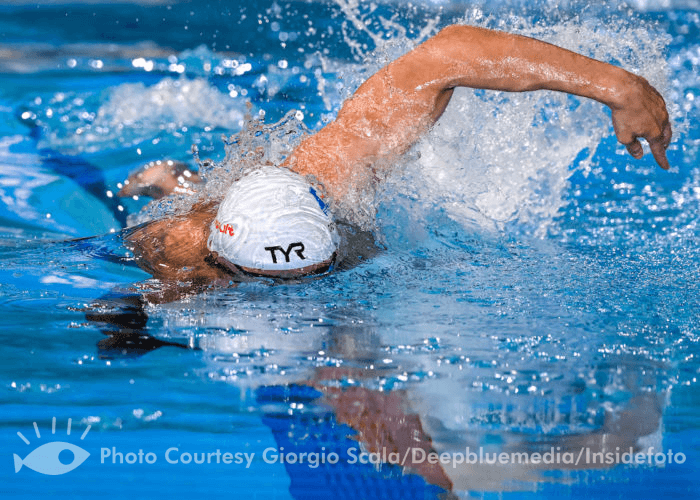The Age of Underwater Racing: How Hypoxic Training (Done Safely) Can Make You a Better Swimmer

The Age of Underwater Racing: How Hypoxic Training Can Make You a Better Swimmer
Swimming has traditionally been an above-the-water sport. With new tools and techniques, swimmers can spend more time underwater, which speeds up their race times. This shift toward underwater racing has caused some swimmers to rethink their training methods. Hypoxic training is one technique that has grown in popularity among swimmers. Hypoxic training is a technique that involves swimming sets with low oxygen levels. This technique prepares the body to perform better in low-oxygen environments, such as the underwater portion of races.
Adding hypoxic training to your swimming routine can help you improve your lung capacity, endurance, and overall performance in the water. However, hypoxic training MUST be done correctly. It is very important to work with a qualified coach who can guide you through the process and make sure you train safely. With the proper training and preparation, you can take your swimming to the next level and achieve tremendous success in the water.
USA Swimming Safety Recommendations
How To Incorporate Hypoxic Training Into Your Swimming
One method for incorporating hypoxic training is gradually reducing breathing time during swim sets. Start by swimming one length of the pool without pausing to breathe, then gradually increasing the distance as you gain confidence. Another option is to use hypoxic training equipment, such as swim snorkels, to limit the oxygen you receive during your swim sets. Remember that hypoxic training should only be done under the supervision of a qualified coach, who can track your progress and ensure you’re training safely and effectively. Furthermore, it is critical to gradually increase the amount of hypoxic training over time to avoid injury and overexertion. You can improve your endurance, lung capacity, and overall performance in the water.
Kicking Off the Wall
Swimmers can incorporate this type of training into their workouts by kicking off the wall while underwater. Using kick-out sticks during swim practice is one excellent technique to accomplish this goal. Kick-out sticks are usually set at different distances from the wall, and swimmers must kick off the wall and reach the stick before coming up for air. Swimmers can improve their underwater endurance and ability to function in low-oxygen environments. As they get used to being underwater, they can gradually increase their distance before they need to breathe. Swimmers can use this strategy to improve their lung capacity. To avoid overexertion and injury, begin cautiously and gradually increase the distance between the wall and the kick-out stick.
How Hypoxic Training Can Improve Your Swimming
- Reduced fatigue during competitions: Hypoxic training helps athletes become more tolerant of and adapt to lower oxygen levels during intensive exercise. Red blood cells, which deliver oxygen to the muscles, can be produced by the body more efficiently due to this exercise. More red blood cells allow the body to deliver more oxygen to the muscles, which helps to postpone the beginning of exhaustion and increase endurance. This implies that athletes can work harder for a longer amount of time before being worn out.
- Possibility to improve stroke technique: Athletes often engage in low-intensity activities that let them concentrate on form and technique when exercising in a low-oxygen environment. This is because doing high-intensity activities becomes more difficult due to decreased oxygen levels. Athletes can increase their effectiveness and performance overall while lowering their risk of injury and reaching their full potential by concentrating on technique and form.
- Increase in the body’s capacity to utilize oxygen: By increasing the density of capillaries (tiny blood vessels) around the muscles, hypoxic training can enhance the body’s ability to use oxygen. This increases the quantity of oxygen given to the muscles during exercise, boosting energy production and lowering the buildup of lactic acid in the muscles. Moreover, this training can promote the creation of enzymes essential for generating energy, improving the body’s oxygen utilization.
Hypoxic training is a type of swimming training that involves intentionally limiting oxygen intake. It can help swimmers get stronger and last longer by improving their ability to carry oxygen, maintain lung function, and handle high levels of lactic acid. Training in an environment with reduced oxygen levels causes the body to adapt by producing more red blood cells, which carry oxygen to the muscles more efficiently. This makes it easier to make energy from oxygen, which is essential for swimming long distances. Additionally, hypoxic training can improve the swimmer’s overall breath control, making them more efficient swimmers. If you follow these tips and pay attention to how your body reacts to hypoxic training, you can safely add it to your swimming routine and reap its many benefits.




We have found that increasing oxygen intake is actually more effective for improving performance than hypoxic training. The fact that our 17 Olympic swimmers have won 43 Gold Medals and set 11 World Records after we increased their oxygen intake confirms this. Most elite level swimmers can expand their chests only 2-3 inches, mainly as a result of doing too much ‘core’ work which tightens up the abdominal muscles attaching to the lower ribs and too many bench presses, push-ups, and pull-ups which tighten up the muscles that attach to the upper ribs. As we release the tension in these muscles and the microfibers (mild scar tissue) between theses muscles, our swimmers have doubled and tripled their chest expansion, which has increased their lung capacity up to 33%. Coaches and swimmers should measure chest expansion. Optimum expansion for swimming is 20% of chest circumference. One national record holder we measured had 9″ of chest expansion. He reported he never got tired during a race. We have attached some before and after photos.